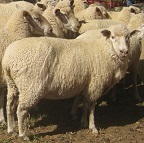

Wool: content limited to the general process from Fleece to Woollen Item with a focus on home-based processing.
These few words are a summary of the steps involved from harvesting the wool to producing a woollen item.
- For a start, a fleece can come from a variety of sources - most commonly sheep, goat (typically angora), and alpaca.
- The quality of the fleece varies based upon the breed and the conditions of the animal during the wool growing cycle.
For example, merino wool tends to be finer in microns than cross-bred wool: commonly from 16 microns for superfine merino wool, to around 19 microns for merino wool and up to 30 microns for cross-bred wool.
If the animal has gone through tough times during the 9 to 12 to 18 months of wool growth (depending on the shearing cycle), there could be visible breaks in the wool staples.
Other factors affecting the fleece is the rainfall (causing water stains), the dust, and the weeds.
The shearing process can also affect a good fleece. It takes 12 months or so to grow the fleece and 3 minutes for a careless shearer cutting too far away from the sheep skin to significantly reduce the quality and value of the fleece. - Once shorn, the wool is classed in the shearing shed according to quality.
- Once classed, the wool is pressed into 200kg wool bales of even quality and generally sold through wool brokers at auctions.
- The commercial buyers have to organise the processing of wool. This starts with the scouring process which removes the grease and the dirt, and eventually ends with a woollen item.
- The details of the entire process is beyond the scope of this page.
Here is an interesting book relating to understanding wool and spinning: The Intentional Spinner >> get Book details
This section explores the home-based process of producing a woollen item once a fleece has been acquired.
- Carding is the process of preparing the fleece for spinning.
I use a dog comb and comb the fleece away from the skin end aiming at thinning the wool a little and removing excess grease and unwanted excess such as weeds.
Some use a carding drum. Some remove around 50% wool in this process. I prefer removing as little as possible, in fact just enough so I can spin without too much trouble with grease or weeds getting in the way. - Spinning is the process of manually guiding the wool fibre into a continuous thread generally using a spinning wheel.
Once a bobbin is full, another bobbin is filled.
Further notes on spinning:- As the bobbin gets filled and the treddling gets harder, try and release the tension on the bobbin and apply more tension on the wheel.
- Spinning Wheel Maintenance: Replacing the leather strap: use 2 screws; allow about 1 inch (ie ~2.54cm) of give.
- Plying:
To make a multiple-ply thread, bobbins are spun together in the opposite direction to the spinning process (ie anti-clockwise).
Two-ply is generally the minimum amount for the thread to have any strength.
The number of plies is up to the spinner and the project in mind.
Further notes on plying:- As you ply, separate both threads by at least one finger so the threads do not tangle up.
- Washing:The bobbin is then emptied on a niddy-noddy and the wool is tied so it can be washed.
Washing is generally at a hot temperature (as hot as a hand can bear it). Rinsing is at a lesser temperature.
Rinsing at a temperature hotter than the wash temperature is likely to felt the wool.
The wool is hung to dry.
The dry wool is then made into a ball hence ready to be knitted or wowen. - Caring for the wool so it does not get damaged by moth overtime can be tricky.
When the fleece is still awaiting to be spun and kept in a tight garbage bag, it can be left open on a frosty night outside with the hope that moths get killed.